58th Venice Biennale, Part 4: National Pavilions in Sale D’Armi
By HG Masters
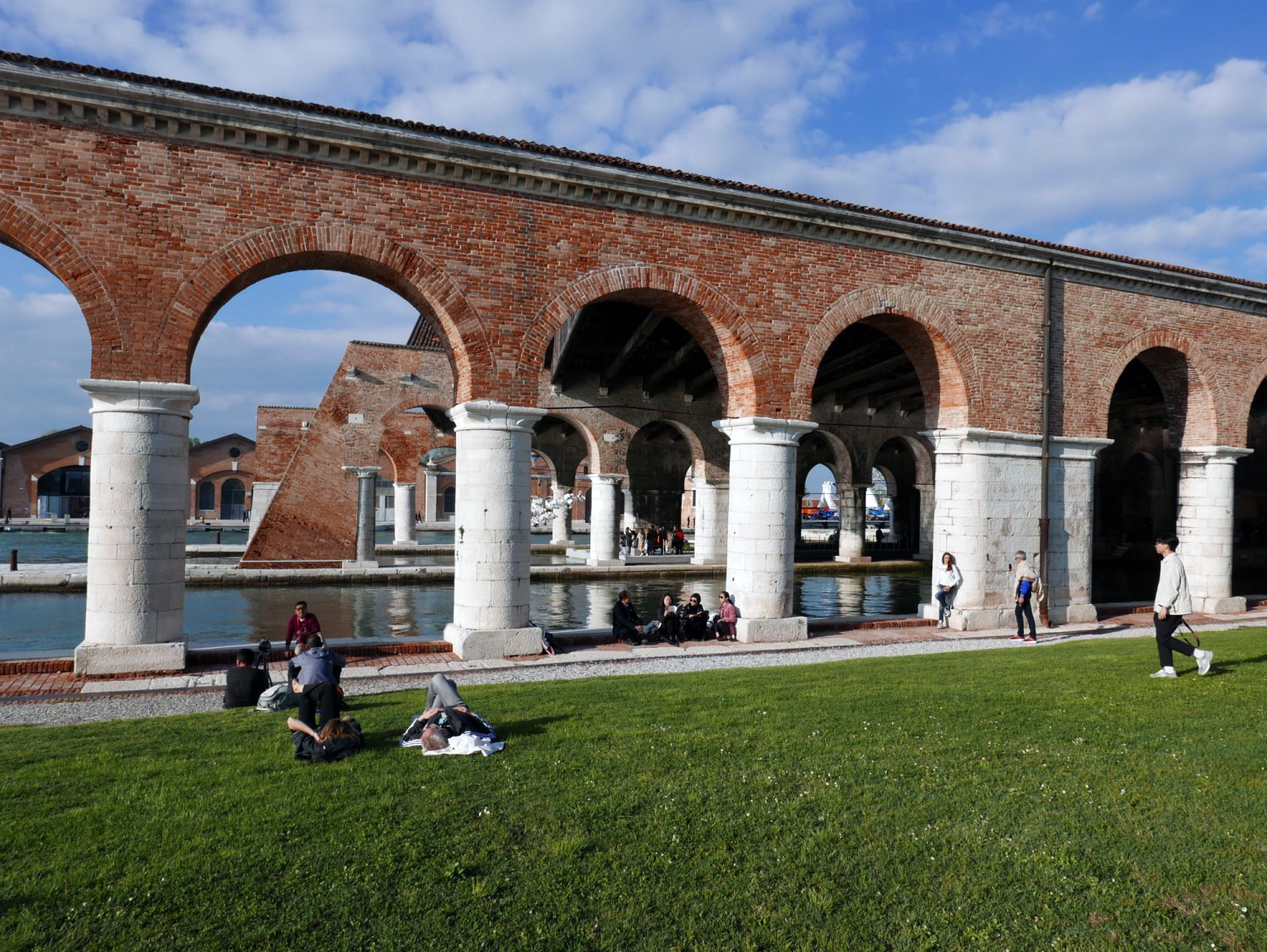
View of the Arsenale in Venice. All photos by HG Masters for ArtAsiaPacific unless otherwise stated.
The “Meetings on Art” series, organized by Delfina Foundation director Aaron Cezar, took place during the opening week of the Venice Biennale. One afternoon I caught four events taking place in the Giardino delle Vergini, the garden at the far end of the Arsenale compound, past the China Pavilion. A stage had been set up on the ground in an area encircled by a grassy mound. There, wearing a black suit and white shirt, boychild—a frequent collaborator with artists including Wu Tsang and Korakrit Arunanondchai—performed a virtuosic 20-minute routine that centered primarily around snapping and flicking movements of the wrists and fingers, as well as bursts from the ankles and or a dramatic flourish of the shoulders and arms thrown back. This was followed, on another stage in the vicinity, by a drag performance by Victoria Sin, whose lip-synced monologue about “naming [as] an act of mastery” was a tedious rehashing of the basic concerns of identity politics, rescued slightly by her incredible costume and a live traverso accompaniment. Back on the other stage, Paul Maheke performed another solo dance with periodic bursts of music, while engaging in moments of self-conscious reflection on his outfit (shorts, and knee socks like those worn by a footballer), levels of energy, and the duration of the performance. It ended when an alarm sounded. Finally, Tarek Atoui had assembled five musicians to play his custom-designed accoustic and electronic instruments in the garden, in a largely improvised performance. Each of the four performances that afternoon, though distinctive, shared a kind of meta-narration or self-consciousness. In the case of boychild and Atoui, it was engaging, while Sin and Maheke, likely without realizing it, were treading ground that many performers before them have embodied in much more sophisticated and captivating ways.
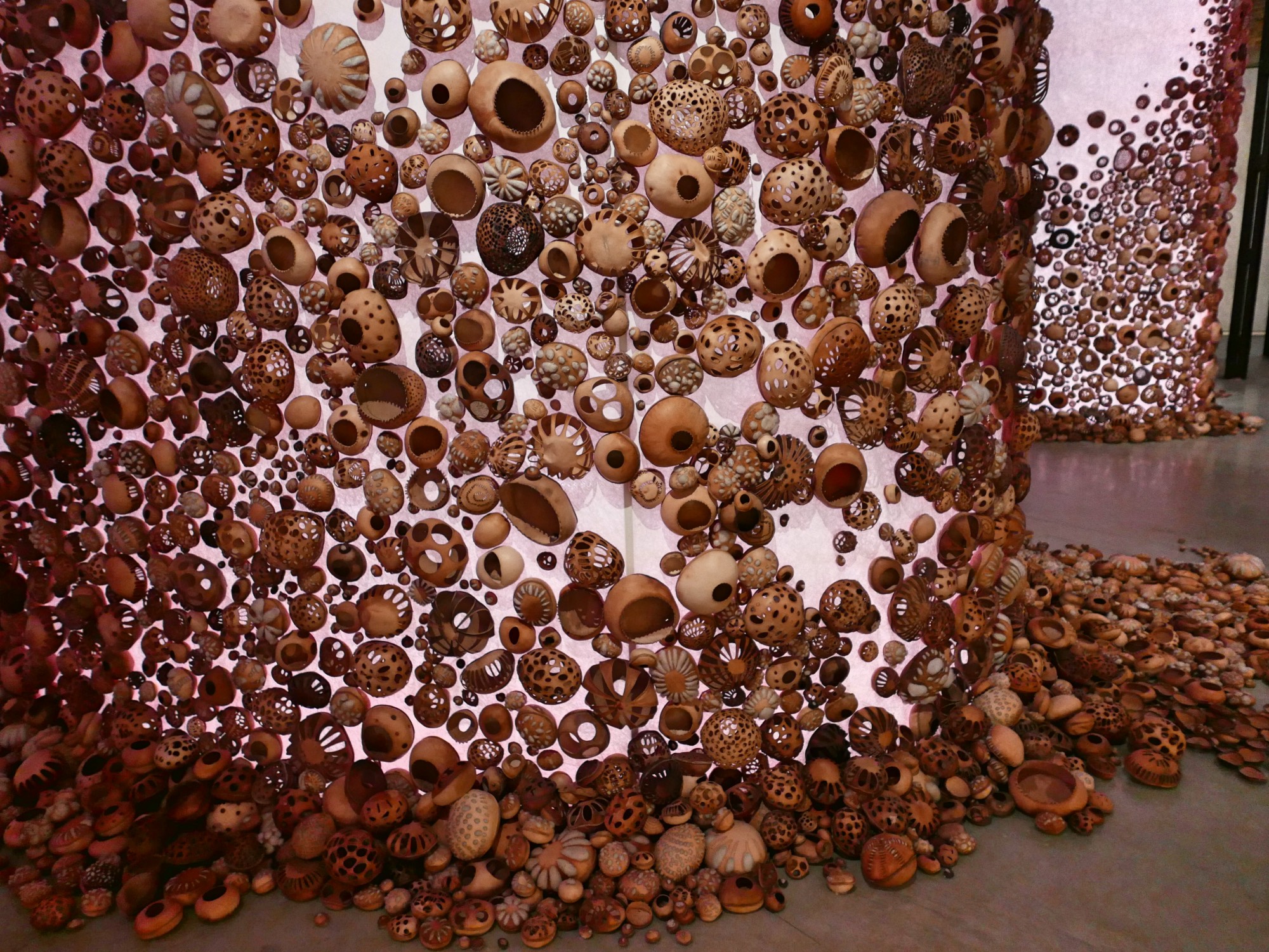
Installation view of ZAHRAH AL-GHAMDI’s "After Illusion" in the Saudi Arabia Pavilion, curated by Eiman Elgibreen, at the 58th Venice Biennale.
Saudi Arabia
Zahrah al-Ghamdi
"After Illusion"
The first Saudi pavilion since 2011, “After Illusion” was a solo presentation by the Jeddah-based artist Zahrah al-Ghamdi, whose recent works have been installations of globular, hand-fashioned leather forms. Inspired by a 6th-century poem written by Zuhayr bin Abi Sulma about the experience of not being able to recognize his home after more than 20 years away, “After Illusion” was a much larger realization of these gourd-size forms adhered to illuminated, curvilinear columns running through the space and along the ground. There were 52,000 of these forms in the exhibition, ranging in size from a few centimeters in diameter and to perhaps 25 or 30 centimeters for the largest. Each is a unique size and shape, perforated with holes of different sizes—some pressed through with bunches of undyed wool—and collectively they resembled a massive colony of fungus that had begun to inhabit the space. While the artist sees them, in curator Eiman Elgibreen's words, as an “embodiment of her old birthplace that [has] been mostly now turned into ruins,” they also bore an unlikely relationship to the old sea-shells found in limestone, or the reddish-yellow stones of the desert, and here perhaps they began to bridge landscape with traditional crafts in a way that reflected the particular heritage of the artist’s native southwestern Saudi landscape.
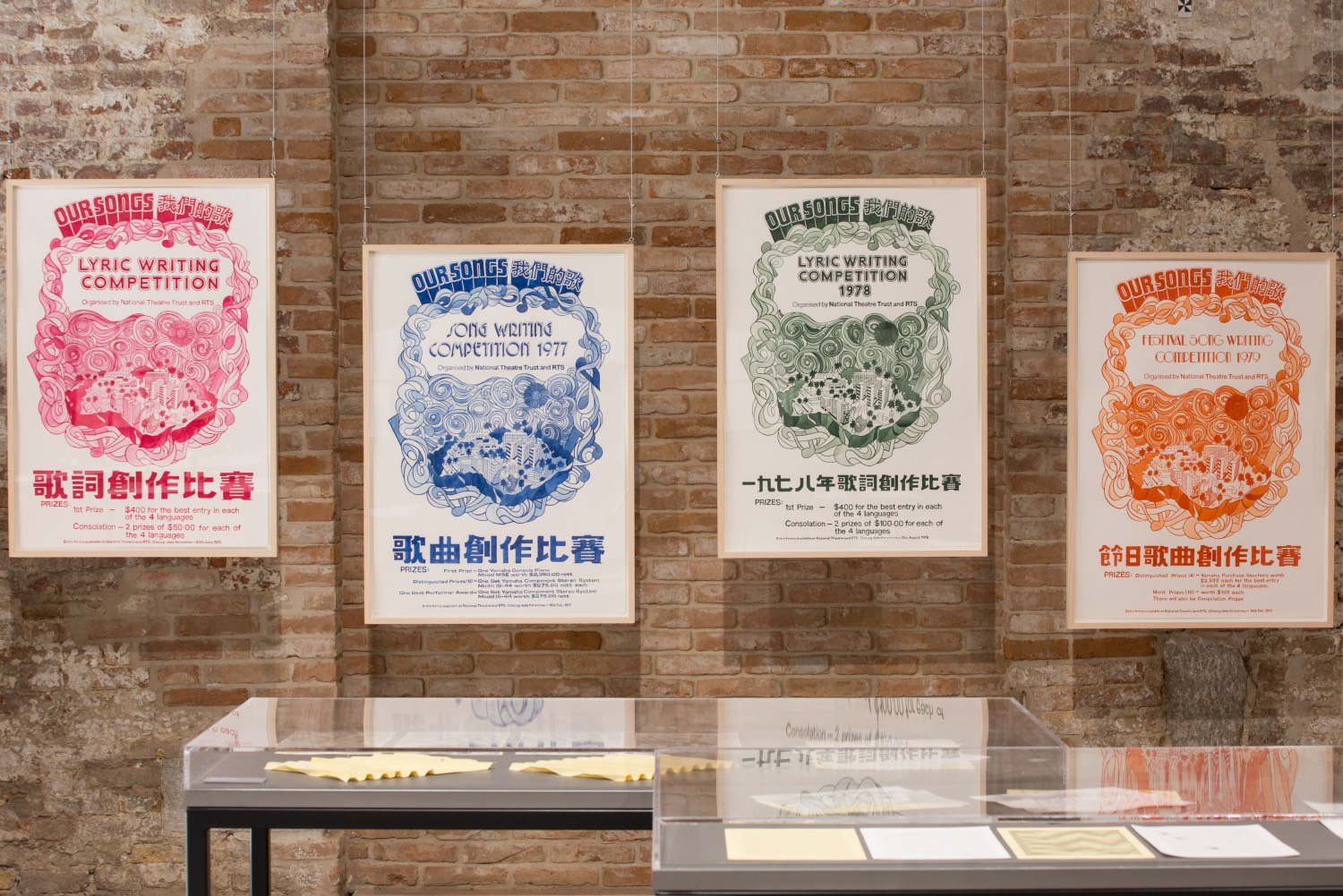
SONG-MING ANG’s series of watercolor paintings, titled "Our Songs," in the Singapore Pavilion, curated by Michelle Ho, at the 58th Venice Biennale.
Singapore
Song-Ming Ang
"Music For Everyone: Variations on a Theme"
In the 1970s, the Ministry of Culture in Singapore organized a series of concerts meant to promote the appreciation of Western classical music as part of its social-engineering campaign to create an identity for the post-British-colonial city-state. Posters from these events—which all used the same graphic design template—suggest a deeply unimaginative agency at work. By contrast, Song-Ming Ang’s project “Music For Everyone: Variations on a Theme,” curated by Michelle Ho, took the forms of classical music education and instead offered a program for how to teach children (and us adult viewers) ways to unlearn, or re-learn, conventional ideas of music. The centerpiece of Ang’s pavilion is the three-channel video installation Recorder Rewrite, shot in the Singapore Conference Hall with a cast of children. The scenes of the video were mapped out in collaboration with the children, who in various scenes are playing the recorders in unconventional ways, often as part of narratives they invented with the artist. Ang similarly focuses on the instrument in a series of sculptural works, for which he dissembled recorder parts and balances them to create new assemblages. In a related series of works on paper, Ang cuts and folds sheets of musical notations to create abstract patterns—another take on the potential for creating new forms from rigid, conventional ones. By introducing non-traditional techniques for using the didactic instrument, Ang’s project can be read as an effort to move beyond the British-imported cultural education that Singapore promoted in the 1970s and still persists today. While Ang’s project encourages young people to break out of the strictures of classical education, the gentleness of his approach makes for a tepid rather than robust critique. Maybe there’s virtue in subtlety—it is a government-sponsored pavilion, after all—and this will permit it a wide circulation, but for outside viewers it is not a captivating experience.
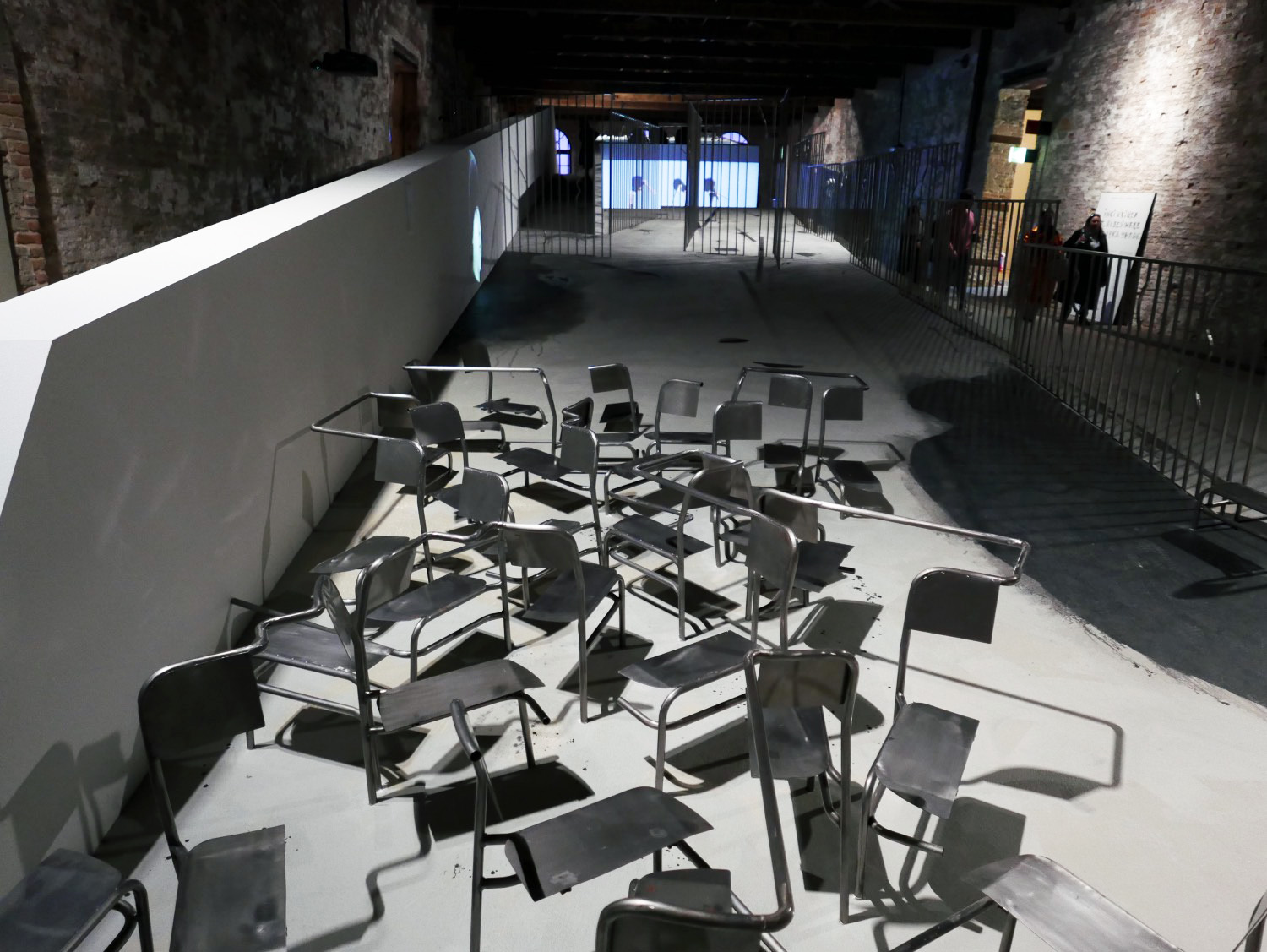
Installation view of
Turkey
İnci Eviner
"We, Elsewhere"
İnci Eviner’s architectural installation We, Elsewhere is a long ramp structure embedded with videos and sculptural objects that fills the long hall of the Turkey Pavilion’s space in Sale d’Armi. The ramp begins with a cluster of bent metal poles, and then a series of chair-like metal forms that have been sawed in half. Midway up the ramp is a small maze of metal bars overlooking an enclosed area below, where an animated video—featuring a hybrid whale-submarine form, with looping clips of dancers performing short, absurdist gestures—is projected onto the floor. Another video, projected onto the far wall, shows three performers whose limbs are partially effaced by inky black forms (Eviner is also known for her paintings in black acrylic and ink, several of which are shown along the sides of the ramp structure) as they perform mournful and consoling movements together. On top of this latter video is a surface embedded with the faces, like death masks or figures entombed. One of the paintings on the side features the figure of political theorist Hannah Arendt seen from behind, along with the phrases “Memory Rescue Centre,” “Howls of Hearing,” and “Figures of Healing”—serving perhaps as a codex to the gestures and themes of the installation, while evoking Arendt’s essay “We Refugees” (1943). The prison-like metal forms and fragmented bodies of the performers suggest kinds of psychic trauma related to oppression and detention, and perhaps to the experience of leaving behind parts of oneself even when one escapes from a specific context. Many of the allusions in We, Elsewhere evoke the context of Turkey today, where imprisonment remains the state’s tactic for handling its outspoken critics, opposition groups, and those it blames for failed coup d’état in 2016). “It seems as if some people are in search of their minds, their repressed emotions and gestures, their unfinished stories scattered among the layers of this stage split in half,” the artist cryptically stated in the official press release. Though Eviner’s work invites the Biennale viewer into and through this structure, it is nevertheless hard to see Eviner’s work other than in the context of Turkey’s current situation instead of in more general, existential terms. Not that Eviner’s work is ever explicit or agitprop, but there’s a limit here, too, in what can be said openly in the context of a National Pavilion that, while organized by the private nonprofit Istanbul Foundation for Culture and Arts (İKSV), is still under the official auspices of Turkey’s foreign ministry, which perhaps contributes to the installation’s evasive, allegorical tone.
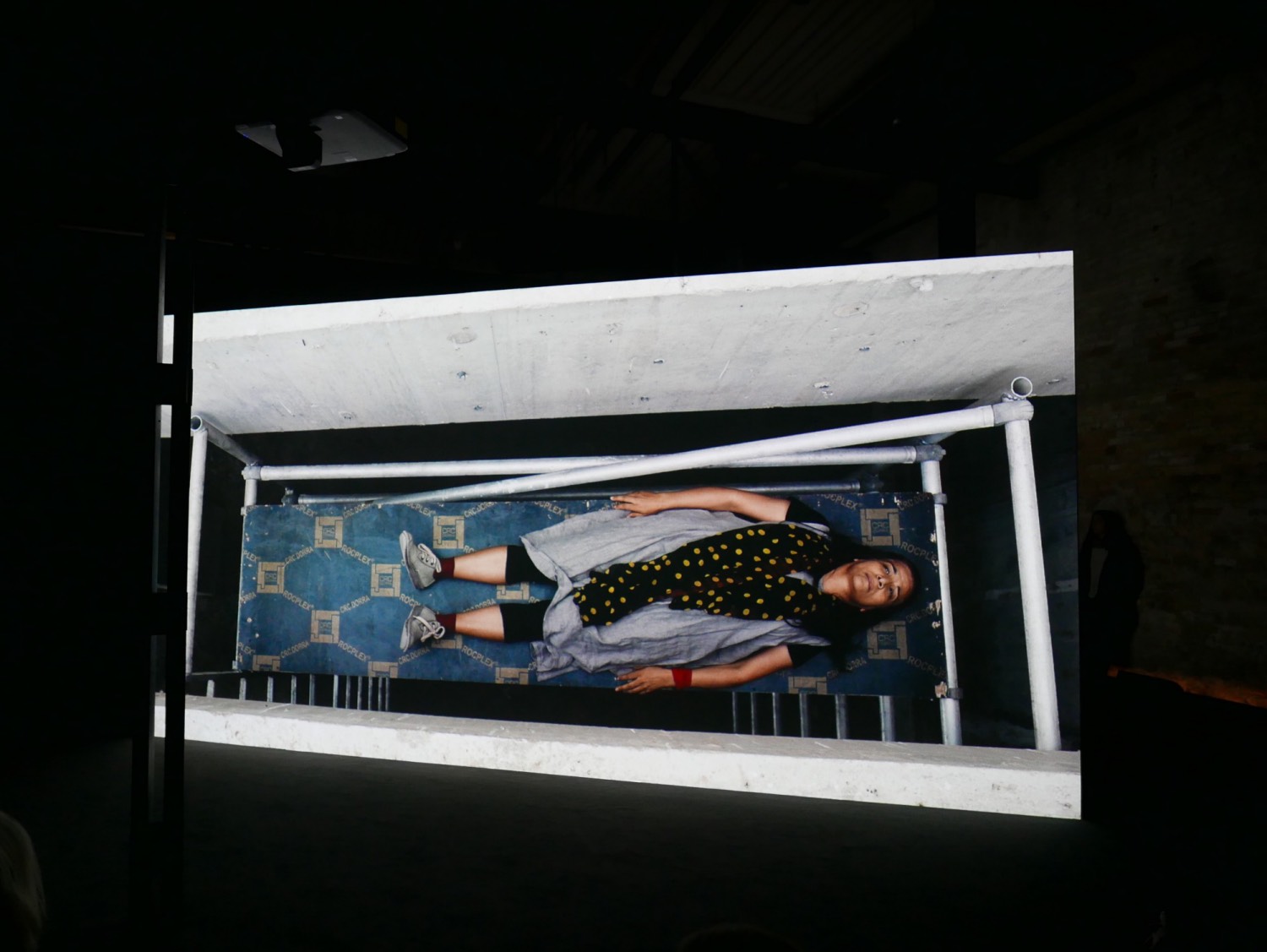
Installation view of NUJOOM ALGHANEM’s "Passage" in the United Arab Emirates Pavilion, curated by Sam Bardouil and Till Fellrath, at the 58th Venice Biennale.
United Arab Emirates
Nujoom Alghanem
"Passage"
The UAE Pavilion, titled “Passage” and curated by Sam Bardouil and Till Fellrath, comprises a dramatic, two-channel video installation by Emirati poet, artist, and filmmaker Nujoom Alghanem, based on her 2009 poem The Passerby Collects the Moonlight, about the experience of displacement. The 26-minute video’s two halves are projected onto opposite sides of a three-by-six-meter screen, with one 12-channel soundtrack uniting what are described as the “real” and “fictional” halves of the work. The former depicts Alghanem, the Syrian actress Amal Hawijeh, and others preparing the film, while the fictional narrative follows a woman named Falak (played by Hawijeh) on an arduous voyage, walking across desert with a suitcase, crossing the sea on a boat, sleeping in the scaffolding of a half-finished building, and hiding in an old Venetian building that is revealed to be the pavilion space itself. At several points in the narrative, Nujoom herself reads segments of her poetry, while Falak’s dialogue is rendered in an unrecognizable language. Throughout the video, you find yourself wanting to see what is happening on the other side of the screen at that moment, leading you to either walk between the two halves, or to watch one side then the other. The powerful imagery of the fictional portion—in particular, scenes of Falak in a yellow raincoat floating on her back with her suitcase next to her—is revealed, on the opposite screen, in equally dramatic footage taken with a drone, shot in a pool on a rooftop in the UAE. More than deconstructing imagery of the fictional portion, the “real” portion situates the “fictional” in the context of the UAE today, where so many people who are displaced or are economic migrants go to live and work, adding realism to the allegories of Passage.
HG Masters is the deputy editor and deputy publisher of ArtAsiaPacific.
The 58th Venice Biennale is on view at various locations in Venice until November 24, 2019.






